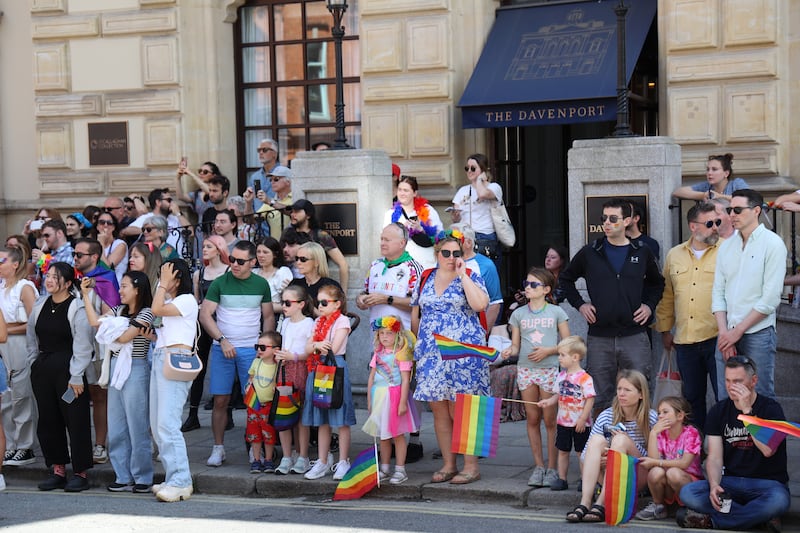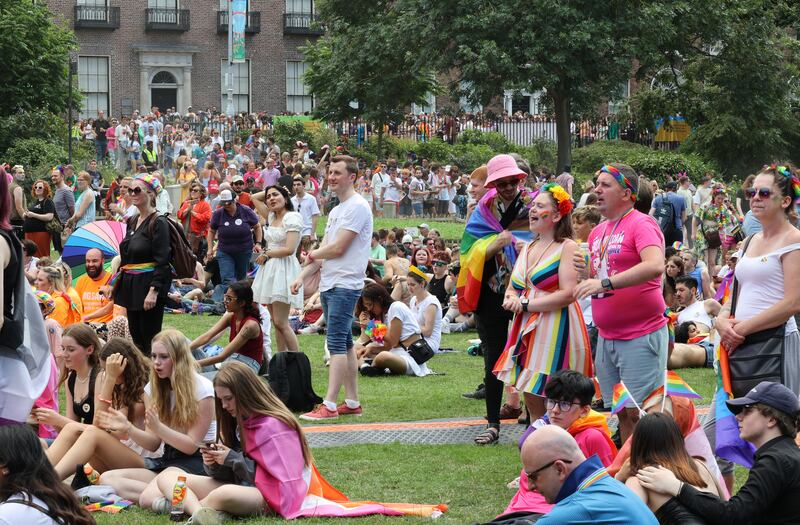It was a carnival of every colour under the rainbow at Dublin’s 40th annual Pride parade on Saturday, an event that would make a Harry Styles concert look tame.
Dublin’s streets belonged to the “girls, gays and theys” and everyone else on a beautiful midsummer’s day.
Crowds thronged the city centre in the 25-degree heat to celebrate those who dance to a different beat in life, and boy did they dance, with one attendee overheard saying that the parade was busier than London Pride last year.
People of all ages were in attendance, with some pushing buggies and walkers alike. The parade had something for literally everyone, all shapes, all sizes, all genders, all races and all sexualities – as it should be.
READ MORE
The atmosphere is one of acceptance, with a few young girls who were attending the parade for the first time saying that that’s exactly what the event meant to them. They could be themselves and didn’t have to worry about what others thought.
[ Ireland’s first Pride parade, 40 years agoOpens in new window ]
[ A look back at a decade of Pride paradesOpens in new window ]
How life should be seems to be a running theme with the Pride parade. Showing people how to live, how to love, how to accept people for who they are.
In the more residential areas, people were out on their balconies with flags and music, showing their support from afar, and in true Dublin fashion, there were children offering refreshments – and Pride stickers, of course – on the side of the road.
The shouts of “hats, scarves and headbands” were replaced by “bags, whistles and neckchains”, with even the usual punters found outside Croke Park getting involved in the festivities, selling rainbow-themed attire streetside.
Mirrin Craig was late for the parade because it took him longer to get ready than he thought it would, but donning a pink mesh skirt – matching his pink beard – his delay did not deter his spirit.
He said that every time he gets the Dart to work, seeing the flags along the river in June “gives that sense of belonging, and that Dublin is kind of safe, and it’s a good place to be”.
His first Pride parade was 13 years ago in 2010, not long after he had come out.
“I didn’t have any gay friends and none of my other friends seemed interested, but I got one of my friends, Sarah, and the two of us went to Dragon [nightclub],” he said, “and it was a very last minute thing, so I was just wearing like a white T-shirt and jeans.”
However, Mirrin met people in the toilet of Dragon, and ended up having a rainbow drawn across his face with their eyeshadow, of course, and “the sense of belonging, community, everyone came together,” paired with the fact that his friend decided to go with him so he could go to his first Pride parade, makes it a standout memory for him.

Lanna Danger, a drag queen originally from Brazil, said that pride for her was “the wisdom, because it’s a place we can be free and we can be ourselves”.
The parade can be emotional for some too, with drag sisters – and husbands – Valdiva Carrara and Lindsey O’Brien attending Pride for their first time this year. They moved to Dublin from Brazil only a month ago.
“I’m very proud and very emotional because I come from a little city from Brazil and it is not possible to celebrate pride there and here I can be myself and celebrate why I am what I am and it’s amazing. I’m speechless,” Valdiva said.
Seáneen Sullivan recalled her standout pride memory while watching the parade go by: “I think the first pride after the marriage equality referendum, because I think it was the first time where it felt like the whole country was celebrating with us,” she said, becoming emotional thinking about it, “because marriage equality was such a hard-won thing.”
However, she was keen to reiterate that pride is still a protest, as “there’s so many things to protest about including lack of trans access to healthcare, there’s still systemic inequalities, but ultimately it is an opportunity for to come together and celebrate our communities”.
Daniel Houlihan from Limerick is “no longer a Dublin Pride virgin” after Saturday’s festivities, and he admitted that the capital’s parade is much better than those in Limerick and Cork, “because the popularity is much bigger, so everyone from around the world and around Ireland comes here for pride.”

Tommy Dunne, also from Limerick, gushed about how good it is that “children are being exposed to the meaning behind pride”, as lots of families were in attendance.
[ My first Pride: ‘We wore our wedding dresses’Opens in new window ]
One such family was the Keegans from Dublin, with their two children Ruadh and Aoibhí.
“We’re just here for a fun day, really, this little guy [Ruadh] likes colours with rainbows and colourful clothing so we decided to come out and show him some people that like to wear clothes like that,” dad Alan Keegan said.
Ruadh went on to tell The Irish Times of the wide array of feathers he collected during the parade and the colours he found of each.
“It’s a great day though, there’s so many people out, [the kids], they don’t understand what it’s all about but we’re just saying it’s a day for everybody, and that everybody can dress like they want and be whoever they want,” Jennifer Keegan said, in between Ruadh telling me that his sister saw some feathers that he did not.
Ciarán and Tanya Ferry, also from Dublin, also brought their four children to the parade, “for the craic”.
“We wanted to say that this is important, this is where we live, that we’re proud of this and that we stand by this and we wanted our kids to see it and to understand it,” Tanya said.
“We want to normalise it, it shouldn’t be different it should be celebrated, and it’s something that I’m very proud of here in Dublin,” she says.













